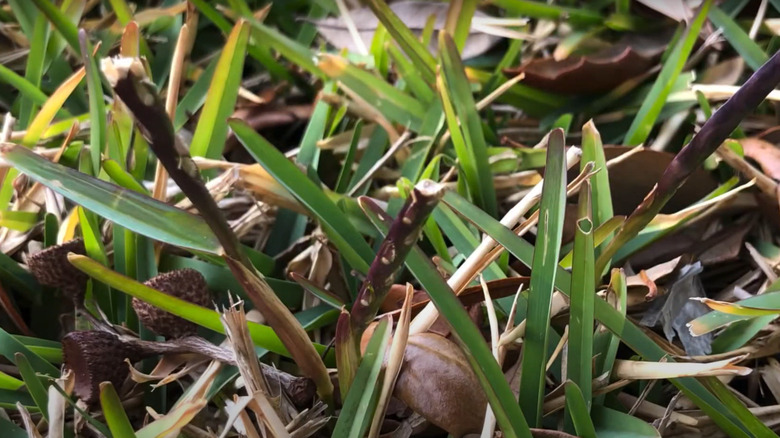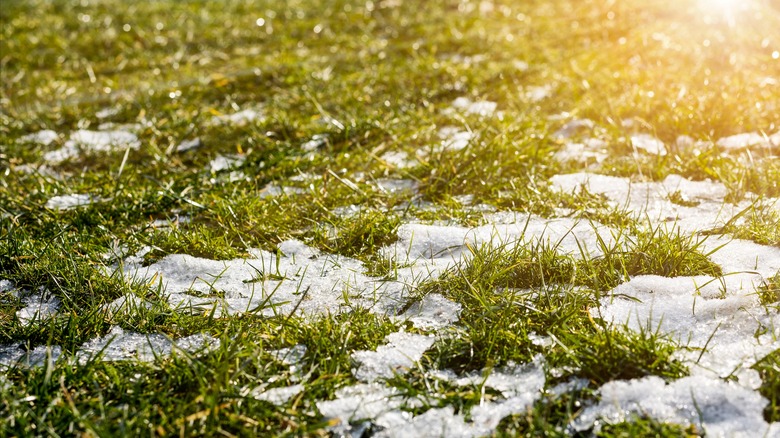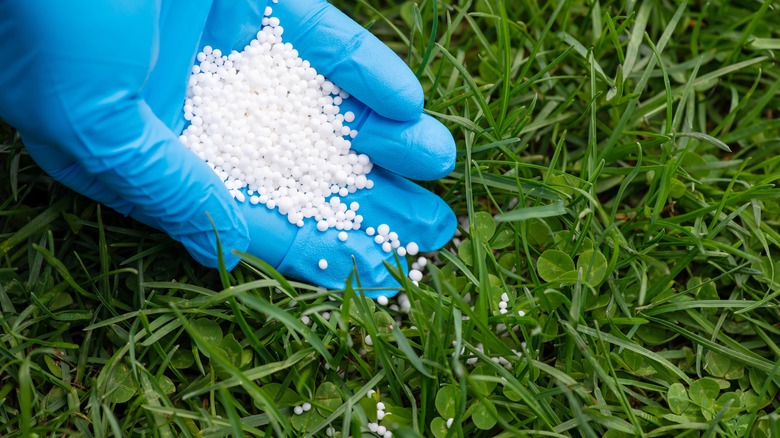What It Means When Your Green Lawn Starts To Turn Purple
Although purple symbolizes "majesty," its presence plays out contrarily in lawns by divesting them of their lush beauty. Around fall and spring, many grasses turn into unsightly purple, red, or brown patches, which could make you wonder if they suffer from diseases. While an infestation is not out of the question, the color change is usually benign and a mere response to adverse environmental conditions. Disliking seasonal changes, turfgrasses are quick to hit the panic button when the prevailing light conditions change materially, and the reason may surprise you. Unlike trees and plants, grasses don't contain many anthocyanins — pigments responsible for red, purple, or blue colors in vegetation — to begin with. But when exposed to intense lighting, especially blue light, for a sustained period, they can often initiate the production of anthocyanins. As you can imagine, their enormous concentration in the swards causes the green lawn to appear purple.
While this is the most common cause of purple grass and typically isn't a cause for concern, you may be dealing with other issues. For instance, your lawn may have low levels of phosphorus. You could also be underwatering your lawn, as water stress can elicit a purpling response in the grass as well. Footprinting – the failure of blades to spring back after being walked on — indicates a thirsty lawn.
Photoinhibition typically turns the lawn purple
Usually, green leaves require more than 1,000 micromoles per square meter per second of light to produce anthocyanins, but these requirements fall drastically when the weather turns cold. Temperatures below 50 degrees Fahrenheit reduce the light and heat grasses require for photosynthesis since they're getting ready for sleep. But if they remain exposed to moderate light intensity (around 800 micromoles per square meter per second) in conjunction with low temperatures, they become stressed, experiencing "low-temperature photoinhibition." This phenomenon is quite common during sunny fall days. As a result, the grasses start building up anthocyanin levels and adopt purple hues.
Similar events transpire when the snow begins to thaw and the sun appears come spring. The previously shaded turfgrasses are stimulated to produce and accumulate gigantic amounts of anthocyanins after facing an onslaught of powerful sunbeams while recovering from cold stress. The situation is particularly stark for tufts planted around deciduous trees, since the routine leaf shedding deprives them of the additional shade protection. The same goes for newly seeded grasses, as their immature blades are too busy struggling to grow to bother with improving their stress susceptibility. High foot traffic, lawnmower injuries, and topdressing a prematurely greening lawn right after a frosty night or a cold snap can add insult to the injury.
Purple lawns grow slowly
Granted, green grass transmuting into purple is typically a cosmetic nuisance, but it isn't the end for your yard. The higher anthocyanin levels lend the swards sun protection, swiftly keeping them warm with the seasonal changes. So, luckily for you, replacement and resodding are not in order. However, greater anthocyanin concentrations do slow down the establishment of new sod and the growth of the existing turfgrasses compared to their never-turned-purple counterparts. This applies even after the environmental conditions have turned favorable.
That being said, photoinhibition affects diverse grass seed varieties differently. For instance, St. Augustine's Bitterblue and Classic varieties are more likely to turn purple in duress, whereas rough bluegrass is largely unaffected. While there isn't much you can do to minimize cold stress, draping newly seeded grasses with a shade cloth during extreme winters should reduce low-temperature photoinhibition by limiting their light exposure. Also, apply 0.1 to 0.2 pounds of nitrogen for every 1,000 square meter area to promote healthier growth spurts when the day and night temperatures stabilize to over 70 and 45 degrees Fahrenheit, respectively. But if your grass doesn't naturally regreen as the cold abates, get your soil tested for phosphorous deficiencies and treat the lawn accordingly.


